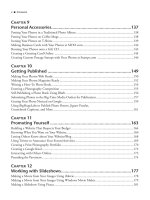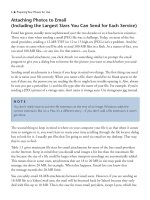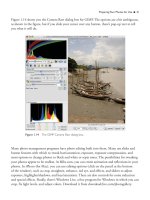101 Quick and Easy Ideas Taken from the Master Photographers of the Twentieth Century
Bạn đang xem bản rút gọn của tài liệu. Xem và tải ngay bản đầy đủ của tài liệu tại đây (15.77 MB, 254 trang )
101
QUICK AND EASY
IDEAS TAKEN FROM THE
MASTER PHOTOGRAPHERS
OF THE TWENTIETH
CENTURY
Matthew Bamberg
Course Technology PTR
A part of Cengage Learning
Australia, Brazil, Japan, Korea, Mexico, Singapore, Spain, United Kingdom, United States
© 2010 C
ourse Technology, a part of Cengage Learning.
ALL RIGHTS RESERVED. No part of this work covered by the copyright
herein may be reproduced, transmitted, stored, or used in any form or by
any means graphic, electronic, or mechanical, including but not limited to
photocopying, recording, scanning, digitizing, taping, Web distribution,
information networks, or information storage and retrieval systems,
except as permitted under Section 107 or 108 of the 1976 United States
Copyright Act, without the prior written permission of the publisher.
For product information and technology assistance, contact us at
Cengage Learning Customer & Sales Support, 1-800-354-9706
For permission to use material from this text or product,
submit all requests online at cengage.com/permissions.
Further permissions questions can be e-mailed to
Al
l trademarks are the property of their respective owners.
All images © Matthew Bamberg unless otherwise noted.
L
ibrary of Congress Control Number: 2009933303
ISBN-13: 978-1-4354-5436-1
ISBN-10: 1-4354-5436-7
Course Technology, a part of Cengage Learning
20 Channel Center Street
Boston, MA 02210
USA
Cengage Learning is a leading provider of customized learning solutions
with office locations around the globe, including Singapore, the United
Kingdom, Australia, Mexico, Brazil, and Japan. Locate your local office at:
international.cengage.com/region.
Cengage Learning products are represented in Canada by Nelson
Education, Ltd.
For your lifelong learning solutions, visit courseptr.com.
Visit our corporate Web site at cengage.com.
101 Quick and Easy Ideas Taken
from the Master Photographers
of the Twentieth Century
Matthew Bamberg
Publisher and General Manager,
Course Technology PTR:
Stacy L. Hiquet
Associate Director of Marketing:
Sarah Panella
Manager of Editorial Services:
Heather Talbot
Marketing Manager:
Jordan Casey
Executive Editor:
Kevin Harreld
Project Editor/Copy Editor:
Cathleen D. Small
Technical Reviewer:
Ron Rockwell
Interior Layout:
Shawn Morningstar
Cover Designer:
Mike Tanamachi
Indexer:
Larry Sweazy
Proofreader:
Kim V. Benbow
Printed in the United States of America
1 2 3 4 5 6 7 11 10 09
eISBN-10: 1-
4354-5587-8
To Brenda
Acknowledgments
Throughout much of the twentieth century, creating a photograph was both an exploratory
and an arduous process. From dealing with oversized cameras to using homemade darkrooms,
taking the photo from its initial composition to a processed print was truly a feat of perseverance.
I’d like to thank all those photographers who were engaged in that. I’d like to thank Todd Larson
for his endless assessment of my photos and his support and encouragement during the writing
process. In addition, I’d like to thank Kevin Harreld for reading my proposals and helping to
make this photography book series possible. Last but not least, special thanks go to Cathleen
Small, who has managed to keep me on track with both my writing and my research.
About the Author
Matthew Bamberg is the author of the 101 Quick and Easy Secrets photography book series,
which covers everything from creating winning photographs to using your photographs and
emulating the great twentieth-century photographers. Bamberg began his career in the arts as
a graduate student at San Francisco State University in 1992. His work in the visual and media
arts included video production and software applications. He completed his M.A. in Creative
Arts in 1997. After being a public school teacher for 14 years, Bamberg became a photographer
and writer. He began to photograph for the articles he was writing while working for the
Desert Sun and Palm Springs Life magazine. He has traveled the world, photographing in the
most remote of places from Burma to Bolivia. His photographs have appeared in international
magazines, galleries, and retail stores. Bamberg is also the author of The 50 Greatest Photo
Opportunities in San Francisco.
Books in the 101 Quick and Easy Secrets photography book series include:
❈ 101 Quick and Easy Secrets to Create Winning Photographs
❈ 101 Quick and Easy Secrets for Using Your Digital Photographs
❈ 101 Quick and Easy Ideas Taken from the Master Photographers of the Twentieth Century
This page intentionally left blank
Contents
CHAPTER 1
Berenice Abbott (1898–1991) 1
Barbershop Photography 2
Building Soup 2
The Power of Negative Space 5
CHAPTER 2
Ansel Adams (1902–1984) 9
Photographing and Photoshopping Trees 10
Redefining Sky 12
Reflecting Freeway Light in Black and White 13
Perspective Revised 15
CHAPTER 3
Robert Adams (1937– ) 17
Black Smoke 18
Smoggy Light 19
Scrawling in Pristine Lands 20
CHAPTER 4
Eugène Atget (1857–1927) 23
Le Cirque Shadows 24
Catch the Right Angle 26
CHAPTER 5
Bill Brandt (1904–1983) 29
The Wet Cobblestone Street 30
Human Body Parts Close-Ups 32
CHAPTER 6
Brassaï (1899–1984) 35
Surrealist Graffiti 36
Paris (or Any Big City) at Night 38
CHAPTER 7
Harry Callahan (1912–1999) 41
Vast Landscapes with Tiny People 42
Minimalist Windows 43
CHAPTER 8
Henri Cartier-Bresson (1908–2004) 45
Moving Group of People 46
Kids Playing a Game with Spectators 47
CHAPTER 9
Imogen Cunningham (1883–1976) 49
Details of Pattern and Form 50
Zebra Skin 50
CHAPTER 10
Robert Doisneau (1912–1994) 53
Human Interaction with Surroundings 54
Wait for Foreground Subjects 54
Frame the Audience 57
CHAPTER 11
William Eggleston (1939– ) 59
Find Muted Color Tones in a Landscape 60
Photograph an Old Car with an Added Extra 62
Photograph a Bright Color Indoors 62
Find Beauty in Junky Surroundings 64
viii ■ Contents
CHAPTER 12
Walker Evans (1903–1975) 67
Find Showbills on City Walls 68
Frame the Façade of an Old Storefront 69
Isolate Interesting Windows on a Building 71
CHAPTER 13
Lee Friedlander (1934– ) 73
Frame Scenes That Other Photographers Avoid 74
Use a Fence to Add Lines to Your Photo 75
CHAPTER 14
John Gutmann (1905–1998) 77
Shoot an Object with Writing Covering the Entire Surface 78
Place a Person’s Back in the Foreground in a Two-Shot of a Couple Facing Each Other 79
Shoot a Person Performing a Gymnastic Feat 81
CHAPTER 15
Lewis Hine (1874–1940) 83
Document Child Labor 84
CHAPTER 16
André Kertész (1894–1985) 87
Photograph Someone Reading 88
Photograph Your Own Shadow 90
Stage or Find a Still Life 90
CHAPTER 17
William Klein (1928– ) 95
Frame Soda Ads or Signs 96
Photograph Active Children 96
Make Images Grainy 98
Form a Relationship, However Brief, with Your Subjects 99
Contents ■ ix
CHAPTER 18
Dorothea Lange (1895–1965) 103
Photograph Signs of Poverty 104
Shoot Inside of a Streetcar 105
Photograph a Café or a Restaurant Counter 108
CHAPTER 19
Clarence John Laughlin (1905–1985) 111
Frame a Spiral 112
Make a Double Exposure 112
CHAPTER 20
Helen Levitt (1913–2009) 115
Photograph Children Playing 116
Make a Near Match in Colors Duplicated in the Frame 117
Find Animals in Configurations of Three 118
Find Chalk Drawings on the Sidewalk or Building Walls 119
Find a Window with a Subject Looking Out 121
CHAPTER 21
Robert Mapplethorpe (1946–1989) 123
Shoot the Heads of Statues as Profiles 124
Make a Black Background for a Flower Image 124
Frame a Subject Covering Her Face with Her Hands 127
CHAPTER 22
Ralph Eugene Meatyard (1925–1972) 131
Photograph Subjects Wearing Masks 132
Make a Silhouette in Front of a Window 133
CHAPTER 23
Lisette Model (1901–1983) 135
Photograph a Pair of Elderly Women 136
Frame Only the Bottom of People’s Legs 137
x ■ Contents
CHAPTER 24
Tina Modotti (1896–1942) 139
Photograph a Large Group Wearing Hats 140
Photograph Multiple Telephone Wires 140
CHAPTER 25
Arnold Newman (1918–2006) 143
Frame Porches with People 144
Include an Arrow in the Frame 145
Emphasize Shapes in the Frame 146
Frame Clothes Hanging to Dry 148
CHAPTER 26
Marvin Newman (1927– ) 151
Take a Portrait of a Performer in Costume 152
Catch a Passenger through a Bus or Train Window 153
Photograph a Shadow Upside Down (or Rotate an Image with a Shadow in Photoshop) 154
CHAPTER 27
Paul Outerbridge (1896–1958) 157
Photograph a Gas Station 158
Stage a Still Life 158
CHAPTER 28
Gordon Parks (1912–2006) 161
Frame a Musician Playing for Money 162
Find Patterns in Religious Dress 163
CHAPTER 29
Alexander Rodchenko (1891–1956) 165
Use a Variety of Angles to Photograph Objects and Subjects 166
Photograph Repeating Balconies 168
Photograph Buildings from the Bottom Up 169
Make a Photo Montage 170
Contents ■ xi
CHAPTER 30
W. Eugene Smith (1918–1978) 173
Photograph Trails from a Moving Vehicle 174
CHAPTER 31
Aaron Siskind (1903–1991) 177
Place People in Motion on a White Background 178
Find Abstract Art on Walls 182
Find Abstract Art in Architecture 183
CHAPTER 32
Frederick Sommer (1905–1999) 185
Remains of Animals 186
Frame a Landscape without a Horizon 186
CHAPTER 33
Stephen Shore (1947– ) 189
Photograph an Old Car in an Old Neighborhood 190
Take a Picture of a Parking Lot from Above 192
Shoot a Landscape of a Road with Two-Thirds of the Frame Filled with Sky 192
CHAPTER 34
Julius Shulman (1910–2009) 197
Avoid Converging Lines in the Frame 198
Choose Indoor/Outdoor Settings 200
CHAPTER 35
Alfred Stieglitz (1864–1946) 203
Find Dead or Dormant Branches in Front of a Cloud 204
Rotate Cloud Photographs 205
Zoom in Close When Photographing a Celebrity 207
Photograph a Reflection of Subjects/Objects in a Body of Water 208
xii ■ Contents
CHAPTER 36
Paul Strand (1890–1976) 211
Isolate Buildings from Exterior Elements 212
Photograph a Toadstool 212
Find Architectural Shadows That Border on the Abstract 214
Make a Fence Your Primary Subject 214
CHAPTER 37
Edward Weston (1886–1958) 217
Photograph a Lake Scene from the Top of a Hill 218
Frame Vegetation against the Sea 219
Find Programmatic Architecture 220
Index 223
Contents ■ xiii
Introduction
Have you ever seen a photograph in a museum and thought, “I can do that”? With today’s
digital technology and a dSLR camera, there’s quite a bit you can do to emulate those museum
pieces. 101 Quick and Easy Ideas Taken from the Master Photographers of the Twentieth Century
helps you to recognize some of the techniques used by the great photographers of the twentieth
century.
Each chapter in the book includes a bio of the master photographer (including what life events
influenced his or her work) and a description of one or several photographs the photographer
shot. In the photograph descriptions, I have described the elements of photography that apply
to that work—light, shadow, subject, narrative, and symbolism. I’ve then re-created a similar
photo with one key element that the master photographer used to produce it. Although the
master photographers’ images are not included in the book for copyright reasons, a website link
is provided for most images. From there, you can go on to take your own picture using similar
techniques and subjects. In addition, I’ve attempted to use similar subject matter to the master
photographers’ photos. In some cases, I’ve traveled to the exact spot where the master photo-
grapher’s photo was taken (such as the re-creation of William Eggleston’s Roy’s Café scene in
Amboy, California). In others, I’ve re-created a similar scene in a different place (such as finding
a similar scene to Lee Friedlander’s barren street scenes).
Also included in the book are the steps to find, compose, and manipulate the new image. There
are sidebars that detail the steps to make images black and white as well as to create sepia tones
and create softness, among other post-processing techniques.
The Concept
When considering a book about the masters, one mustn’t forget the common concepts that they
used to photograph their subjects. The book covers many. One such concept is taking a picture
from a “worm’s-eye” view—a photograph shot from below to make the subject look big. The
name of this technique comes from the concept of thinking of yourself as a worm looking up.
Another concept master photographers used—framing shots where two disparate subjects
appear to be communicating with each other—is detailed. Whether it is a figure in an ad
communicating with a real person or a figure in one ad communicating with a figure in another,
the result is the same—common, everyday figures are brought to life in ways that people
wouldn’t normally think about.
Introduction ■ xv
Subjects seen from a worm’s-eye view.
In these two ads, one disparate subject appears to be communicating with another.
The photography techniques introduced in this book are ones that the masters used. By no
means am I recommending that you take a shot exactly like the masters did. If I did that, there
would be no room for creativity and continued innovation. The techniques illustrated in the
book are only a starting point from which you can improve your photography. By the time you
have finished reading this book, you’ll have a whole new batch of tricks up your sleeve.
Finally, none of the emulated images are from the master photographers themselves. I have taken
every photo in this book, and I can only say that it was very rewarding to learn new ways of taking
pictures by basing my photography loosely on the master photographers of the twentieth century.
In many of the images, important elements other than the subject may not be noticeably evident
if they are not pointed out. For example, in Dorothea Lange’s The Road West, the starkness along
with the light hitting the road makes it look as if you are right in the picture. She obviously
took the picture from the center of the road. When you go to emulate the shot, you will be
emulating only the subject—and roughly, at that. The other elements of the photograph—light,
color, shades of gray—are up to you to refine.
The symbolism of the photos will also change. In Lange’s The Road West, the road signified the
trip west many people took to find work in California. In the photo you take, the symbolism of
the road you are photographing will be up to you.
xvi ■ Introduction
Lonely roads were the subject matter of many twentieth-century photographers;
however, each had different light, shadows, perspective, terrain, vegetation, and clouds.
Many of the images will be black and white. There are sidebars about how to tweak black-and-
white photos in Raw format, as well as how to create a variety of sepia tones. There is also a
discussion about layers with respect to creating a double exposure. Other sidebars will refer to
the methods of the artist’s work, the photography rules the artist followed and/or broke, and the
methods used to set up and photograph still lifes.
Introduction to the Masters
The list of twentieth-century photographers who created techniques and passed them along to
professional and amateur photographers alike is long. Many of them became well known, each
having created a number of iconic images. After writing this book, I found out that many of the
photographers whose pictures I emulated lived well past age 90, adding further credence to my
hunch that because of the creativity involved and the constantly seeking of life’s refreshing
moments, photographers tend to be around a long time. Another thing I discovered was that
the great photographers (and artists) of the twentieth century were interconnected—they knew
each other and learned from one another.
The book begins with Berenice Abbott, who looked at the world through its architecture from a
number of different orientations. It moves on to Ansel Adams and Robert Adams, who both
defined novel ways to shoot landscapes—the former in the traditional sense and the latter with
a sense of concern about man’s effect on the environment.
Paris is put under the microscope though the photographs of Eugène Atget, Brassaï, and Robert
Doisneau. The first two defined new ways to use light and shadow during the day and at night,
and the third, Doisneau, captured Paris streets through a lens full of unexpected surprises.
Figuring into the photography history equation is Harry Callahan, who looked at people
among vast and endless surroundings, and Imogen Cunningham, who saw details up close in
the simplest of living things. The former viewed humankind as tiny compared to the world at
large, and the latter took elements of plants and animals that we take for granted and put them
in close view to reveal patterns that some may not have known ever existed.
Back in the 1960s, Art Linkletter used to say, “Kids are people, too!” That message is brought to
life by those photographers who framed children playing in the streets. Henri Cartier-Bresson
was a master of composing children observing other children at play, and Helen Levitt caught
the unexpected, from an overweight woman and her two kids stuffed into a phone booth to
chalk drawings on the pavement of New York City streets.
Introduction ■ xvii
No discussion of twentieth-century photography would be complete without a nod to composing
images of the human form. Many photographers went out of their way to disrobe their subjects
(who were often their lovers) to photograph them every which way. Overt eroticism rarely
played a role in these photographs, except, quite possibly, with respect to Mapplethorpe, who
was determined to not only eroticize but also shock.
Many of the master photographers shot in black and white. In the early part of the century,
color film wasn’t available. By the middle of the century, the photographers chose to shoot in
black and white because that was the medium in which fine art photographers worked. A few
mid–twentieth century photographers—William Eggleston and Stephen Shore—broke the
anti-color bias of many in the field and saw color as a way to transform the commonplace into
compelling subject matter. Color comes alive from both photographers in their work, which
took lonely Western outposts, vacuous suburban sprawl, and casual indoor scenes and made
them fit to be seen on the walls of the great art museums of the world.
Then there were the photographers who unraveled messages in text and signage, creating art in
words and letters. Walker Evans and William Klein were pros at this—Evans through sharp,
close-up shots of weathered signs and Klein by using advertisements as his subject matter.
xviii ■ Introduction
Catch the eyes on the girl on the right, an expression similar to what Doisneau might have captured.
During the twentieth century, the Great Depression came on with a tidal wave of economic
blight. Rural and city people alike suffered, as did the American landscape. Dorothea Lange
showed migrant workers and their surroundings up close, using a soft-focus lens, which created
stunning optical effects of creating lifelike subjects that look as if they’re multidimensional.
Photographers Ralph Eugene Meatyard and Frederick Sommer created subjects that ranged
from puzzling to bizarre. Meatyard photographed his family members in masks among rustic
surroundings, and Sommer photographed dead animals.
Romantic relationships between the photographers and other artists cast a spell on all involved.
From Alfred Stieglitz and Georgia O’Keeffe to Tina Modotti and Edward Weston, male photo-
graphing female exposed new revelations in romanticism and sexuality.
This is only the beginning of the great photographers’ inspiring creativity, multitude of images,
and the stories that went along with them during the twentieth century.
Introduction ■ xix
Text and color can change an image’s message.
Abbott photographed downtown high rises from the bottom up, similar to this one.
CHAPTER 1
Berenice Abbott
(1898–1991)
B
erenice Abbott photographed common themes that taught the world about good
photographic composition. She lived in Paris and New York City. In Paris, she
was an assistant to experimental artist Man Ray in the 1920s. In his studio
she photographed portraits of well-known artists and writers, such as author James Joyce,
drummer Buddy Gilmore, and flamboyant artist Jean Cocteau.
During her time in New York City, Abbott worked for the Federal Arts Program. As part
of the program, she photographed the streets of New York during the Depression. Her book,
Changing New York, recorded everything from street corners to architecture and includes images
of buildings that have long since been demolished. She also wrote A Guide to Better Photography
in 1941. She was an admirer of Eugène Atget, whose photos she eventually obtained and promoted
after his death in 1927.
Barbershop Photography
If you happen to pass an old-fashioned barbershop window, you could have an opportunity to
emulate Berenice Abbott. Barber shops symbolize a men-only world that rarely exists in America
anymore. The barbers are disappearing, slowing being replaced by stylists who cut hair at unisex
hair salons. Back in Abbott’s day, barbers were losing their shaving business because people
could do it themselves with the advent of the safety razor.
Abbott has two well-known shots of barbershops. The first—Tri-Boro Barber School—was taken
at 264 Bowery on October 24, 1935. The second—Pingpank Barbershop—was taken at 413
Bleeker Street in Manhattan on May 18, 1938.
You can replicate Abbott’s work in her second photo of the barbershop by photographing a
vintage barbershop in your area. Abbott took her shot by standing on the curb just to the right
of the barbershop in the same way I did in Figure 1.1. (Abbott also uses the same perspective in
Doorway: Tredwell House 29 East 4th Street Manhattan.)
Fortunately for me, the text of Pingpank Barbershop ( />barber.htm) was oriented in the same way as Louie’s in my photo. In the Abbott photo, the
words AUGUST PINGPANK arch across the top of the photo, just the way Louie’s is oriented,
albeit not as elaborately. Also in the Abbott photo, the words BARBER SHOP lie under that
text about a third of the way down the photo, just as the words BARBER SHOP do in the
Louie’s photo. Both photos also have the same orientation. They were taken from a point just to
the right of the window, so that the image appears at a slight angle within the frame.
Also notable in both photos are the reflections. In Abbott’s photo, you can see a horse-drawn
cart; in Figure 1.1, you see the ’20s-era Castro Theater.
Building Soup
Abbott worked with the Federal Arts Project, part of President Franklin Roosevelt’s New Deal.
She shot all around New York City. She’s said to have been influenced by Eugène Atget.
2 ■ Berenice Abbott
She liked his images so much she purchased them right before he died. Many of them were of
Paris architecture. She ended up photographing New York City as Atget photographed Paris.
Atget is discussed in Chapter 4.
Call it building soup if you will—Abbott shot a mixture of architectural styles filling frames to
create contrasting shapes and forms. In Abbott’s Manhattan I (www.mcny.org/museum-collections/
berenice-abbott/a078.htm), a mixture of buildings is set back from the foreground, extending
left to right across the frame.
Berenice Abbott ■ 3
Figure 1.1 Louie’s Barber Shop on Castro Street in San Francisco.
You can get this effect from almost any big-city skyline, provided you’re far enough away from
the downtown area so that the buildings stand out. Abbott studied New York architecture
before she photographed it with an examination of how many stories the buildings were, when
they were built, how they were lit, and where the sun was with respect to the buildings at various
times during the day.
Figure 1.3 shows San Francisco’s skyline from a similar perspective to that of Abbott’s Manhattan I.
The two major buildings in the image were built in the late 1960s. Just as Abbott captured a
sense of time and place in her photo, so does this photo.
4 ■ Berenice Abbott
JUST WHO WAS MAN RAY?
As an artist working with many different kinds of media, Man Ray came to influence many
twentieth-century artists, from Dali to Steiglitz. Man Ray spent much of his time in Paris even
though he was an American. He was one of the few Americans to belong to the surrealist
movement in Paris.
Man Ray was considered a Dadaist—an artist whose
work rejected mainstream art and who was keenly
aware of the early twentieth-century social move-
ments, working for freedom from social constraints.
Dadaism enveloped anything that was taboo in the
art world, from photographs of ceramic toilets to
assemblages made from everyday items.
One of Man Ray’s best-known images is that of a
woman’s eyes and nose shot at an angle with perfect
water drops dotting her face (at www.bbc.co.uk/
photography/genius/gallery/ray.shtml). In creating
Dadaist images, Man Ray brought fourth a new era
in art and photography. Almost anything offbeat,
weird, wild, and/or wonderful was fair game for a
photographic subject.
Figure 1.2 is an example of Dadaism. Not only is it a
bizarre subject, it’s also taken from a unique vantage
point—the same vantage point a man would see it
from as he is urinating.
Figure 1.2 An example of Dadaism.









